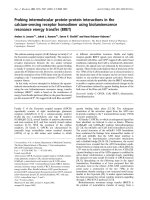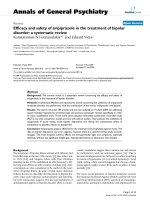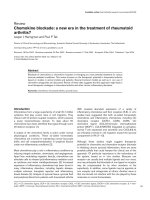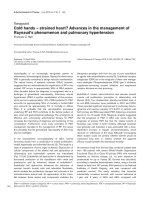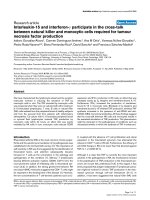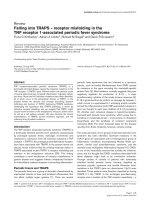Báo cáo y học: "Is succinylcholine appropriate or obsolete in the intensive care unit" docx
Bạn đang xem bản rút gọn của tài liệu. Xem và tải ngay bản đầy đủ của tài liệu tại đây (32.83 KB, 3 trang )
ICU = intensive care unit.
Available online />The use of muscle relaxants in intensive care patients is
rapidly declining. The most important reason for this is the
apparent development of a nondepolarizing, relaxant-
induced neuropathy, which leads to difficulty in weaning
patients from artificial ventilation, among other problems
[1]. Some frequently used drugs, such as corticosteriods
and aminoglycoside antibiotics, contribute to this
neuropathy [2]. Therefore, nowadays relaxants are only
administered in the ICU for specific indications, such as
when decreased muscle tone is required, for treating
patients who fight the ventilator and in order to allow
permissive hypercapnia.
Relaxants are still needed frequently in surgical anaesthesia
to facilitate quick procedures such as endotracheal
intubation. The depolarizing muscle relaxant succinylcholine
is often used for this purpose. Its ultra-short duration of
action renders rapid return of spontaneous breathing
possible if intubation fails. The situation in the ICU is
different, however. During anaesthesia, intubation and
artificial ventilation are only indicated to facilitate surgery by
ensuring an open airway. In the ICU these are absolute
indications, and rapid return of spontaneous ventilation is not
necessary, given that intubation is mainly indicated to start
artificial ventilation.
The potassium problem
Succinylcholine is known to have many unwanted effects. Its
mechanism of action (depolarization of muscle cell
membrane) results in the release of intracellular potassium by
upregulating acetylcholine receptors, especially outside the
motor endplate, and changing their characteristics [3–5].
Potassium release is already massively increased in a number
of circumstances and diseases that are frequently present in
ICU patients, including long-term immobilization, extensive
muscle trauma, many neuromuscular diseases, denervation of
muscles, burns, sepsis, encephalitis and acute renal failure.
Potassium release can be further augmented by acid–base
balance disturbances and by corticosteroids [6,7]. The
induced hyperkalaemia causes arrhythmias and sometimes
cardiac arrest. When such an arrest occurs it is difficult to
resuscitate the patient. In patients with myopathy or those
receiving long-term treatment with corticosteroids,
succinylcholine can contribute to rhabdomyolysis. It is likely
that cardiac arrest in such cases has an even higher mortality
rate than cardiac arrest in succinylcholine-induced
hyperkalaemia alone [8].
Unpredictable activity
In intensive care patients there is large variability in the
activity of plasma cholinesterase, an enzyme that metabolizes
Commentary
Is succinylcholine appropriate or obsolete in the intensive care
unit?
Leo HDJ Booij
Institute for Anaesthesiology, University Hospital Nijmegen, Sint Radboud, Nijmegen, The Netherlands
Correspondence: Leo HDJ Booij,
Published online: 31 August 2001
Critical Care 2001, 5:245-246
© 2001 BioMed Central Ltd (Print ISSN 1364-8535; Online ISSN 1466-609X)
Abstract
Muscle relaxants in intensive care unit (ICU) patients are predominantly administered to facilitate
intubation. The adverse effect profile of succinylcholine is such that its use in the ICU must be
considered obsolete. Suitable alternatives are the intermediately long-acting nondepolarizing relaxants,
of which rocuronium is probably preferable.
Keywords cholinesterase, depolarizing muscle relaxants, intubation, neuromuscular nondepolarizing agents,
succinylcholine
commentary
review reports research
Critical Care October 2001 Vol 5 No 5 Booij
succinylcholine. For example, many drugs decrease plasma
cholinesterase activity, including ecothiopate, bambuterol,
corticosteroids, cytotoxics, anticonceptives and oestrogens.
Heart–lung machines that are used during cardiac surgery
induce a decrease in plasma cholinesterase activity, which
lasts for approximately 10 days [9]. Repeated plasma
exchange decreases plasma cholinesterase activity [10]. In
pregnancy (i.e. in patients with HELLP syndrome
[haemolysis, elevated liver enzymes, low platelets],
eclampsia, etc.), plasma cholinesterase activity is markedly
decreased, resulting in a prolonged succinylcholine effect
[11]. The same holds for patients with sepsis, malignancy,
burn trauma and liver disease [12]. In such patients there is a
wide variability in the neuromuscular blocking effect, onset
and duration of paralysis caused by succinylcholine [13,14].
Other side effects
Muscle hypertonia, myalgia, hypersalivation, elevated
intraocular and intracranial pressures, and induction of
malignant hyperthermia are also side effects of
succinylcholine [15]. Occasionally, harmful cardiovascular
effects also occur following succinylcholine administration,
caused by stimulation of nicotinic receptors in the autonomic
ganglia (sympathetic and parasympathetic) and of cardiac
muscarinic receptors [16]. Furthermore, succinylcholine
increases plasma noradrenaline (norepinephrine)
concentrations, resulting in cardiovascular effects. Finally, the
histamine-releasing properties of muscle relaxants are well
known, and succinylcholine has the strongest histamine-
releasing effect of all such agents.
Alternatives to succinylcholine
Given the profile described above, it is unlikely that many
authorities would approve succinylcholine for registration if it
were presented today as a new drug. Nondepolarizing muscle
relaxants do not have the deleterious effects connected with
depolarization. In order to be useful for facilitating endotracheal
intubation in the ICU, they must have an acceptable speed of
onset, have a relatively short to intermediate duration of action,
be noncumulative, and preferably should not have
cardiovascular side effects or induce histamine release.
Candidates to replace succinylcholine for intubation include
vecuronium, rocuronium, atracurium, cisatracurium and
mivacurium. The features of each drug are summarized in
Table 1. The onset of action of atracurium, cisatracurium and
vecuronium is rather long, and atracurium and cisatracurium
can release histamine. Rocuronium has an onset of action
similar to that of succinylcholine, and provides similar
intubation conditions 1 min after administration [17].
However, its duration of action is longer. The duration of
action of mivacurium is shorter, but it has a slower onset, the
intubation conditions are comparable only after 4–5 min, and
it has stronger histamine-releasing properties than does
rocuronium. Because mivacurium is metabolized by plasma
cholinesterase, the interindividual variability in effect is as
wide as with succinylcholine [18]. Many studies have shown
that rocuronium is a highly acceptable replacement for
succinylcholine in the ICU; therefore, in my opinion,
succinylcholine is obsolete.
Competing interests
None declared.
References
1. Heckmatt JZ, Pitt MC, Kirkham F: Peripheral neuropathy and
neuromuscular blockade presenting as prolonged respiratory
paralysis following critical illness. Neuropediatrics 1993, 24:
123-125.
2. Barohn RJ, Jackson CE, Rogers SJ, Ridings LW, McVey AL: Pro-
longed paralysis due to nondepolarising neuromuscular
blocking agents and corticosteroids. Muscle Nerve 1994; 17:
647-654.
3. Fiacchino F, Gemma M, Bricchi M, Giombini S, Regi B: Sensitiv-
ity to curare in patients with upper and lower motor neurone
dysfunction. Anaesthesia 1991, 46:980-982.
4. Yentis SM: Suxamethonium and hyperkalaemia. Anaesth Inten-
sive Care 1990, 18:92-101.
5. Martyn JAJ, White DA, Gronert GA, Jaffe RS, Ward JM: Up-and
down regulation of skeletal muscle acetylcholine receptors.
Effects on neuromuscular blockers. Anesthesiology 1992, 72:
822-843.
6. Schwartz DE, Kelly B, Caldwell JE, Carlisle AS, Cohen NH: Suc-
cinylcholine-induced hyperkalemic arrest in a patient with
severe metabolic acidosis and exsanguinating hemorrhage.
Anesth Analg 1992, 75:291-293.
7. Kindler GH, Verotta D, Gray AT, Gropper MA, Yost CS: Additive
inhibition of nicotinic acetylcholine receptors by corticos-
teroids and the neuromuscular blocking drug vecuronium.
Anesthesiology 2000, 92:821-832.
Table 1
Suitability of relaxants for use in the ICU
Parameter Vecuronium Rocuronium Atracurium Cisatracurium Mivacurium
Onset of action ± ++ ± ± ±
Duration ± ± ± ± +
Histamine +++ +++ – ± –
Cardiovascular ++ + ± + +
Noncumulative – – + + +
The number of ‘+’s or ‘–’s indicates the degree to which the drug is favourable or unfavourable with respect to the parameter under question.
8. Gronert GA: Cardiac arrest after succinylcholine. Mortality
greater with rhabdomyolysis than receptor upregulation.
Anesthesiology 2001, 94:523-529.
9. Shearer ES, Russell GN: The effect of cardiopulmonary bypass
on cholinesterase activity. Anaesthesia 1993, 48:293-296.
10. Collard CD, Baker BW II, Johnson D, Bressler R, Harati Y: Cumu-
lative reduction in serum cholinesterase following repeated
therapeutic plasma exchange. J Clin Anesth 1996, 8:44-48.
11. Robson N, Robertson I, Whittaker M: Plasma cholinesterase
changes in the puerperium. Anaesthesia 1986, 41:243-249.
12. Blanloeil Y, Delaroche O, Tequi B, Gunst JP, Dixneuf B: Pro-
longed apnea after suxamethonium administration during
staphylococcal toxic shock [in French]. Ann Fr Anesth Reanim
1996, 15:189-191.
13. Vanlinthout LEH, van Egmond J, De Boo T, Lerou JGC, Wevers
RA, Booij LHDJ: Factors affecting magnitude and time course
of neuromuscular block produced by suxamethonium. Br J
Anaesth 1992; 69:29-35.
14. Jensen ES, Viby-Mogensen J: Plasma cholinesterase and
abnormal reaction to succinylcholine: twenty years experi-
ence with the Danish Cholinesterase research Unit. Acta
Anaesthesiol Scand 1995, 39:151-156.
15. Kelly RE, Dinner M, Turner LS, Haik B, Abramson DH, Daines P:
Succinylcholine increased intraocular pressure in the human
eye with the extraocular muscles detached. Anesthesiology
1993, 79:948-952.
16. Flynn PJ, Goldhill DR: Hemodynamic effects of neuromusuclar
blocking agents. J Cardiothorac Anesth 1990, 4:31-37.
17. Kopman AF, Klewicka MM, Kopman DJ, Neuman GG: Molar
potency is predictive of the speed of onset of neuromuscular
block for agents of intemediate, short, and ultrashort duration.
Anesthesiology 1999, 90:425-431.
18. Ostergaard D, Jensen FS, Jensen E, Viby-Mogensen J: Influence
of plasma cholinesterase activity on recovery from mivac-
urium-induced neuromuscular blockade. Acta Anaesth Scand
1989, 33(suppl 191):164.
Available online />commentary
review reports research

